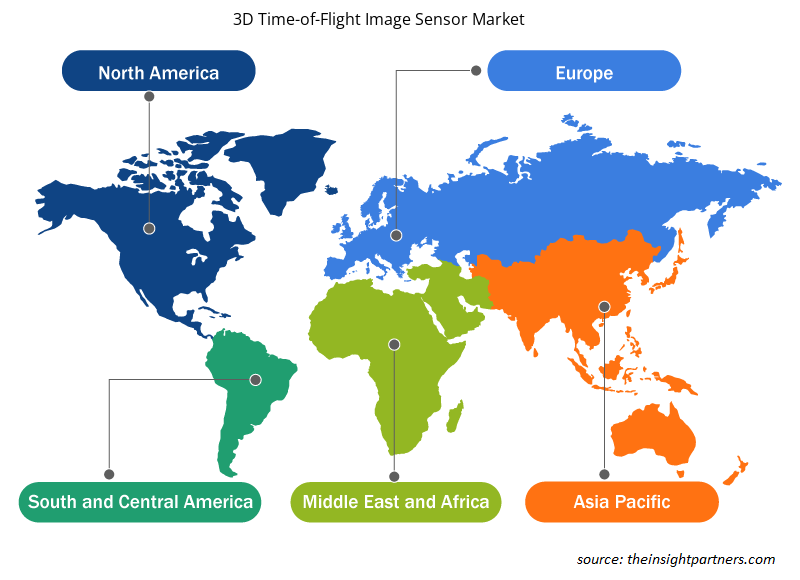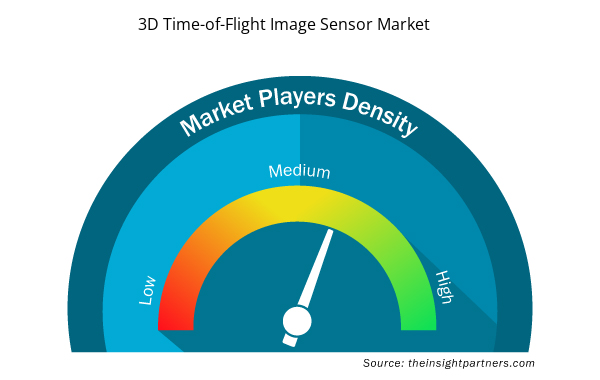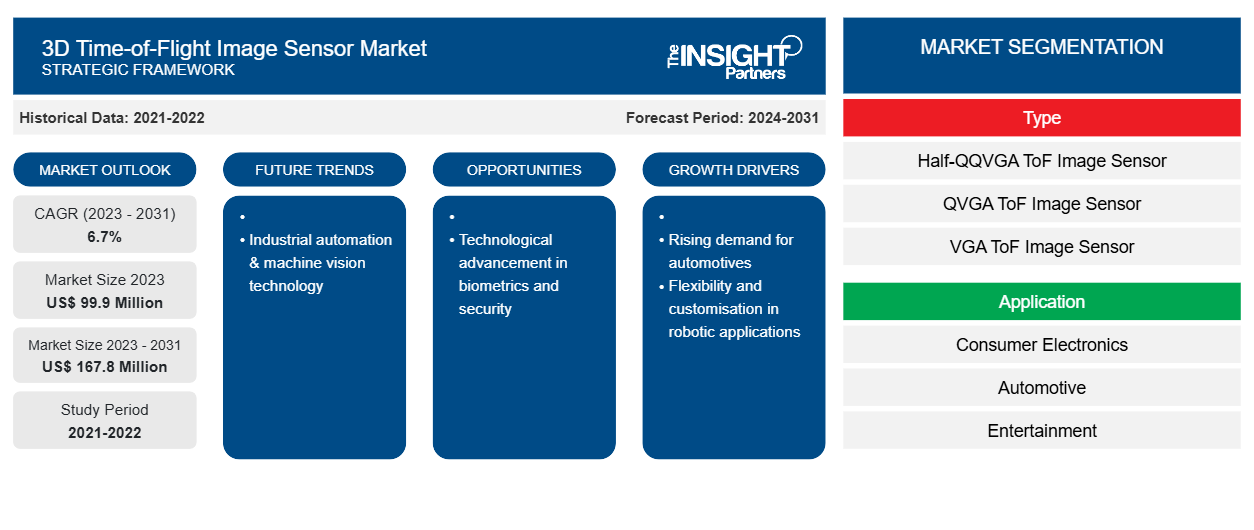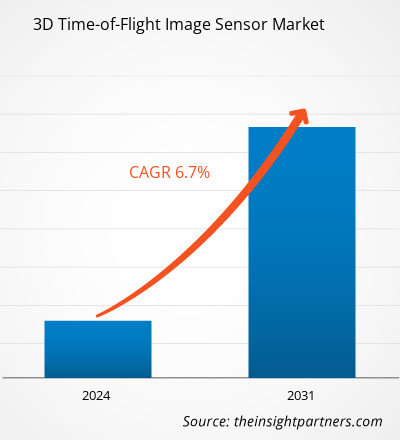3D 飞行时间图像传感器市场规模预计将从 2023 年的 9990 万美元增至 2031 年的 1.678 亿美元。预计 2023-2031 年市场复合年增长率为 6.70%。消费电子设备需求的不断增长以及机器人应用的灵活性和定制化可能仍是全球 3D 飞行时间图像传感器市场的主要趋势。
全球 3D 飞行时间图像传感器市场分析
专为内部传感而设计的 TOF 系统通常使用单个 VCSEL 在 1 米范围内提供 1%(相当于 1 厘米)的距离精度。在机器人应用中使用飞行时间 (TOF) 传感器具有许多优势。与通过图像分析处理的 2D 摄像头视频流相比,这些传感器通常提供更准确的深度测量。此外,TOF 摄像头以缺乏移动部件、紧凑的外形和具有成本效益的生产而闻名。它们对于实时应用尤其有价值,能够以高达每秒 60 帧的速度提供极其精确的深度数据。
全球 3D 飞行时间图像传感器市场概览
3D 飞行时间 (TOF) 图像传感器技术是机器视觉行业的一项革命性进步。通过利用低成本 CMOS 像素阵列和有源调制光源,该技术可实现 3D 成像。它通过测量光脉冲穿过介质传播一段距离所需的时间来工作。这项突破性的创新允许实时获取物理世界的真实 3D 深度图。它有效地将场景、周围环境和捕获图像中的所有对象转换为数字空间。然后使用传感器的内置算法来测量任何物体与光源之间的相对距离以及物体的尺寸。
定制此报告以满足您的需求
您可以免费定制任何报告,包括本报告的部分内容、国家级分析、Excel 数据包,以及为初创企业和大学提供优惠和折扣
- 获取此报告的关键市场趋势。这个免费样品将包括数据分析,从市场趋势到估计和预测。
全球 3D 飞行时间图像传感器市场驱动因素和机遇
消费电子产品与汽车行业的融合日益加深,自动驾驶汽车的需求也日益增长
汽车行业经历了重大变革,以改善驾驶体验。如今的汽车变得更加智能,能够自我诊断,并且与道路上其他实体的通信更加先进。高级驾驶辅助系统 (ADAS)、信息娱乐系统和汽车远程信息处理等趋势在汽车行业中越来越受欢迎。这些进步很大程度上归功于半导体行业的成熟度和技术进步。此外,安全功能的实施导致过去十年的车祸和死亡人数减少。由于电子集成度的提高,车辆现在拥有更强大的计算能力。汽车远程信息处理和用户友好的信息娱乐系统等趋势的出现正以驾驶员和乘客安全为重点进行开发。这些系统还可以检测障碍物、导航并改善车辆内信息娱乐系统的运行。此外,在汽车应用中集成 3D ToF 传感器可实现先进、用户友好和方便的信息娱乐系统操作,包括简单的手势滑动即可在驾驶时切换音乐或广播频道等任务。由于这些进步,预计预测期内汽车市场对 3D 飞行时间传感器的需求将会增加。
生物识别和安全技术发展
生物识别和安全领域的技术飞速发展预计将在不久的将来对 3D 飞行时间图像传感器的需求产生重大影响。这一进步受到各种因素的影响,例如生物识别技术的进步、公众接受度的提高以及对加强安全措施的需求不断增长。生物识别技术的进步推动了生物识别和安全领域的技术快速发展,加速了生物识别系统的采用。例如,较新的系统正在集成人工智能分析以区分 3D 图像和伪造的平面图像,解决了生物识别安全性的局限性并减少了采用障碍。生物识别技术利用可测量的生物特征来验证数字用户身份,包括指纹认证、面部识别、虹膜识别和 DNA 测试。人工智能通常用于分析通过生物识别工具捕获的数据并确认其真实性。
全球 3D 飞行时间图像传感器市场报告细分分析
有助于得出全球 3D 飞行时间图像传感器市场分析的关键部分是类型和应用。
- 根据类型,市场细分为半 QQVGA ToF 图像传感器、QVGA ToF 图像传感器、VGA ToF 图像传感器和 1 MP ToF 图像传感器。QVGA ToF 图像传感器部分在 2023 年占有相当大的市场份额。
- 根据应用,市场细分为消费电子、汽车、娱乐、机器视觉和工业自动化、机器人和无人机等。消费电子领域在 2023 年占据了相当大的市场份额。
全球 3D 飞行时间图像传感器市场份额(按地区)分析
全球3D飞行时间图像传感器市场报告的地理范围主要分为五个地区:北美、亚太、欧洲、中东和非洲、南美/南美和中美。
欧洲的 3D 飞行时间图像传感器市场正在经历显著增长,这得益于各种应用和技术进步。欧洲地区是全球 3D 飞行时间图像传感器市场的关键参与者。汽车、消费电子、工业自动化、机器视觉技术和娱乐等行业对这些传感器的需求不断增长,这是欧洲市场增长的重要驱动力。
全球的
3D 飞行时间图像传感器市场区域洞察
Insight Partners 的分析师已详尽解释了预测期内影响 3D 飞行时间图像传感器市场的区域趋势和因素。本节还讨论了北美、欧洲、亚太地区、中东和非洲以及南美和中美洲的 3D 飞行时间图像传感器市场细分和地理位置。

- 获取 3D 飞行时间图像传感器市场的区域特定数据
3D 飞行时间图像传感器市场报告范围
| 报告属性 | 细节 |
|---|---|
| 2023 年的市场规模 | 9990 万美元 |
| 2031 年市场规模 | 1.678亿美元 |
| 全球复合年增长率(2023 - 2031) | 6.7% |
| 史料 | 2021-2022 |
| 预测期 | 2024-2031 |
| 涵盖的领域 | 按类型
|
| 覆盖地区和国家 | 北美
|
| 市场领导者和主要公司简介 |
|
3D 飞行时间图像传感器市场参与者密度:了解其对业务动态的影响
3D 飞行时间图像传感器市场正在快速增长,这得益于终端用户需求的不断增长,这些需求源于消费者偏好的不断变化、技术进步以及对产品优势的认识不断提高等因素。随着需求的增加,企业正在扩大其产品范围,进行创新以满足消费者需求,并利用新兴趋势,从而进一步推动市场增长。
市场参与者密度是指在特定市场或行业内运营的企业或公司的分布情况。它表明在给定市场空间中,相对于其规模或总市场价值,有多少竞争对手(市场参与者)存在。
在 3D 飞行时间图像传感器市场运营的主要公司有:
- Adafruit 工业
- 艾默生公司
- 易福门电子有限公司
- 英飞凌科技股份公司
- 基恩士公司
- 迈来芯
免责声明:上面列出的公司没有按照任何特定顺序排列。

- 获取 3D 飞行时间图像传感器市场顶级关键参与者概览
全球 3D 飞行时间图像传感器市场新闻和最新发展
通过收集一手和二手研究的定性和定量数据来评估全球 3D 飞行时间图像传感器市场,其中包括重要的公司出版物、协会数据和数据库。以下是市场发展情况的列表:
- 凭借在直接飞行时间传感器领域的领先地位(已售出 20 亿个 FlightSense™ 设备),ST 推出了新的直接和间接飞行时间传感器,用于摄像头辅助、虚拟现实、3D 网络摄像头、机器人和智能建筑等关键应用。市场首款真正的一体式 dToF LiDAR 模块,区域多达 2.3k,面向智能手机摄像头辅助和 AR/VR 应用。世界上最小的 iToF 传感器分辨率为 672×804 像素,目前已在蓝芯科技首次获得设计订单,并已投入量产。
(来源:意法半导体,新闻稿,2024 年)
全球 3D 飞行时间图像传感器市场报告覆盖范围和交付成果
“全球 3D 飞行时间图像传感器市场规模和预测(2023-2031)”报告对以下领域进行了详细的市场分析:
- 范围内所有主要细分市场的全球、区域和国家层面的市场规模和预测
- 市场动态,如驱动因素、限制因素和关键机遇
- 未来主要趋势
- 详细的 PEST/波特五力分析和 SWOT 分析
- 全球和区域市场分析涵盖关键市场趋势、主要参与者、法规和最新市场发展
- 行业格局和竞争分析,涵盖市场集中度、热点图分析、知名参与者和最新发展
- 详细的公司简介
- 历史分析(2 年)、基准年、预测(7 年)及复合年增长率
- PEST 和 SWOT 分析
- 市场规模价值/数量 - 全球、区域、国家
- 行业和竞争格局
- Excel 数据集


- Lyophilization Services for Biopharmaceuticals Market
- Educational Furniture Market
- Explosion-Proof Equipment Market
- Dairy Flavors Market
- Medical Audiometer Devices Market
- Europe Industrial Chillers Market
- Aesthetic Medical Devices Market
- Organoids Market
- Medical Enzyme Technology Market
- Retinal Imaging Devices Market

Report Coverage
Revenue forecast, Company Analysis, Industry landscape, Growth factors, and Trends

Segment Covered
This text is related
to segments covered.

Regional Scope
North America, Europe, Asia Pacific, Middle East & Africa, South & Central America

Country Scope
This text is related
to country scope.
常见问题
The market was estimated to be US$ 99.9 million in 2023 and is expected to grow at a CAGR of 6.70% during the forecast period 2023 - 2031.
Growing demand for consumer electronic devices and flexibility & customization in robotic applications are the major factors that propel the global 3D time-of-flight image sensor market.
Industrial automation and machine vision technology are anticipated to play a significant role in the global 3D time-of-flight image sensor market in the coming years.
The market is expected to reach US$ 167.8 million by 2031
The key players holding majority shares in the market are Adafruit Industries, AMS AG, ifm electronic gmbh, Infineon Technologies AG, and Keyence Corporation.
Trends and growth analysis reports related to Electronics and Semiconductor : READ MORE..
The Insight Partners performs research in 4 major stages: Data Collection & Secondary Research, Primary Research, Data Analysis and Data Triangulation & Final Review.
- Data Collection and Secondary Research:
As a market research and consulting firm operating from a decade, we have published and advised several client across the globe. First step for any study will start with an assessment of currently available data and insights from existing reports. Further, historical and current market information is collected from Investor Presentations, Annual Reports, SEC Filings, etc., and other information related to company’s performance and market positioning are gathered from Paid Databases (Factiva, Hoovers, and Reuters) and various other publications available in public domain.
Several associations trade associates, technical forums, institutes, societies and organization are accessed to gain technical as well as market related insights through their publications such as research papers, blogs and press releases related to the studies are referred to get cues about the market. Further, white papers, journals, magazines, and other news articles published in last 3 years are scrutinized and analyzed to understand the current market trends.
- Primary Research:
The primarily interview analysis comprise of data obtained from industry participants interview and answers to survey questions gathered by in-house primary team.
For primary research, interviews are conducted with industry experts/CEOs/Marketing Managers/VPs/Subject Matter Experts from both demand and supply side to get a 360-degree view of the market. The primary team conducts several interviews based on the complexity of the markets to understand the various market trends and dynamics which makes research more credible and precise.
A typical research interview fulfils the following functions:
- Provides first-hand information on the market size, market trends, growth trends, competitive landscape, and outlook
- Validates and strengthens in-house secondary research findings
- Develops the analysis team’s expertise and market understanding
Primary research involves email interactions and telephone interviews for each market, category, segment, and sub-segment across geographies. The participants who typically take part in such a process include, but are not limited to:
- Industry participants: VPs, business development managers, market intelligence managers and national sales managers
- Outside experts: Valuation experts, research analysts and key opinion leaders specializing in the electronics and semiconductor industry.
Below is the breakup of our primary respondents by company, designation, and region:

Once we receive the confirmation from primary research sources or primary respondents, we finalize the base year market estimation and forecast the data as per the macroeconomic and microeconomic factors assessed during data collection.
- Data Analysis:
Once data is validated through both secondary as well as primary respondents, we finalize the market estimations by hypothesis formulation and factor analysis at regional and country level.
- Macro-Economic Factor Analysis:
We analyse macroeconomic indicators such the gross domestic product (GDP), increase in the demand for goods and services across industries, technological advancement, regional economic growth, governmental policies, the influence of COVID-19, PEST analysis, and other aspects. This analysis aids in setting benchmarks for various nations/regions and approximating market splits. Additionally, the general trend of the aforementioned components aid in determining the market's development possibilities.
- Country Level Data:
Various factors that are especially aligned to the country are taken into account to determine the market size for a certain area and country, including the presence of vendors, such as headquarters and offices, the country's GDP, demand patterns, and industry growth. To comprehend the market dynamics for the nation, a number of growth variables, inhibitors, application areas, and current market trends are researched. The aforementioned elements aid in determining the country's overall market's growth potential.
- Company Profile:
The “Table of Contents” is formulated by listing and analyzing more than 25 - 30 companies operating in the market ecosystem across geographies. However, we profile only 10 companies as a standard practice in our syndicate reports. These 10 companies comprise leading, emerging, and regional players. Nonetheless, our analysis is not restricted to the 10 listed companies, we also analyze other companies present in the market to develop a holistic view and understand the prevailing trends. The “Company Profiles” section in the report covers key facts, business description, products & services, financial information, SWOT analysis, and key developments. The financial information presented is extracted from the annual reports and official documents of the publicly listed companies. Upon collecting the information for the sections of respective companies, we verify them via various primary sources and then compile the data in respective company profiles. The company level information helps us in deriving the base number as well as in forecasting the market size.
- Developing Base Number:
Aggregation of sales statistics (2020-2022) and macro-economic factor, and other secondary and primary research insights are utilized to arrive at base number and related market shares for 2022. The data gaps are identified in this step and relevant market data is analyzed, collected from paid primary interviews or databases. On finalizing the base year market size, forecasts are developed on the basis of macro-economic, industry and market growth factors and company level analysis.
- Data Triangulation and Final Review:
The market findings and base year market size calculations are validated from supply as well as demand side. Demand side validations are based on macro-economic factor analysis and benchmarks for respective regions and countries. In case of supply side validations, revenues of major companies are estimated (in case not available) based on industry benchmark, approximate number of employees, product portfolio, and primary interviews revenues are gathered. Further revenue from target product/service segment is assessed to avoid overshooting of market statistics. In case of heavy deviations between supply and demand side values, all thes steps are repeated to achieve synchronization.
We follow an iterative model, wherein we share our research findings with Subject Matter Experts (SME’s) and Key Opinion Leaders (KOLs) until consensus view of the market is not formulated – this model negates any drastic deviation in the opinions of experts. Only validated and universally acceptable research findings are quoted in our reports.
We have important check points that we use to validate our research findings – which we call – data triangulation, where we validate the information, we generate from secondary sources with primary interviews and then we re-validate with our internal data bases and Subject matter experts. This comprehensive model enables us to deliver high quality, reliable data in shortest possible time.


 获取此报告的免费样本
获取此报告的免费样本